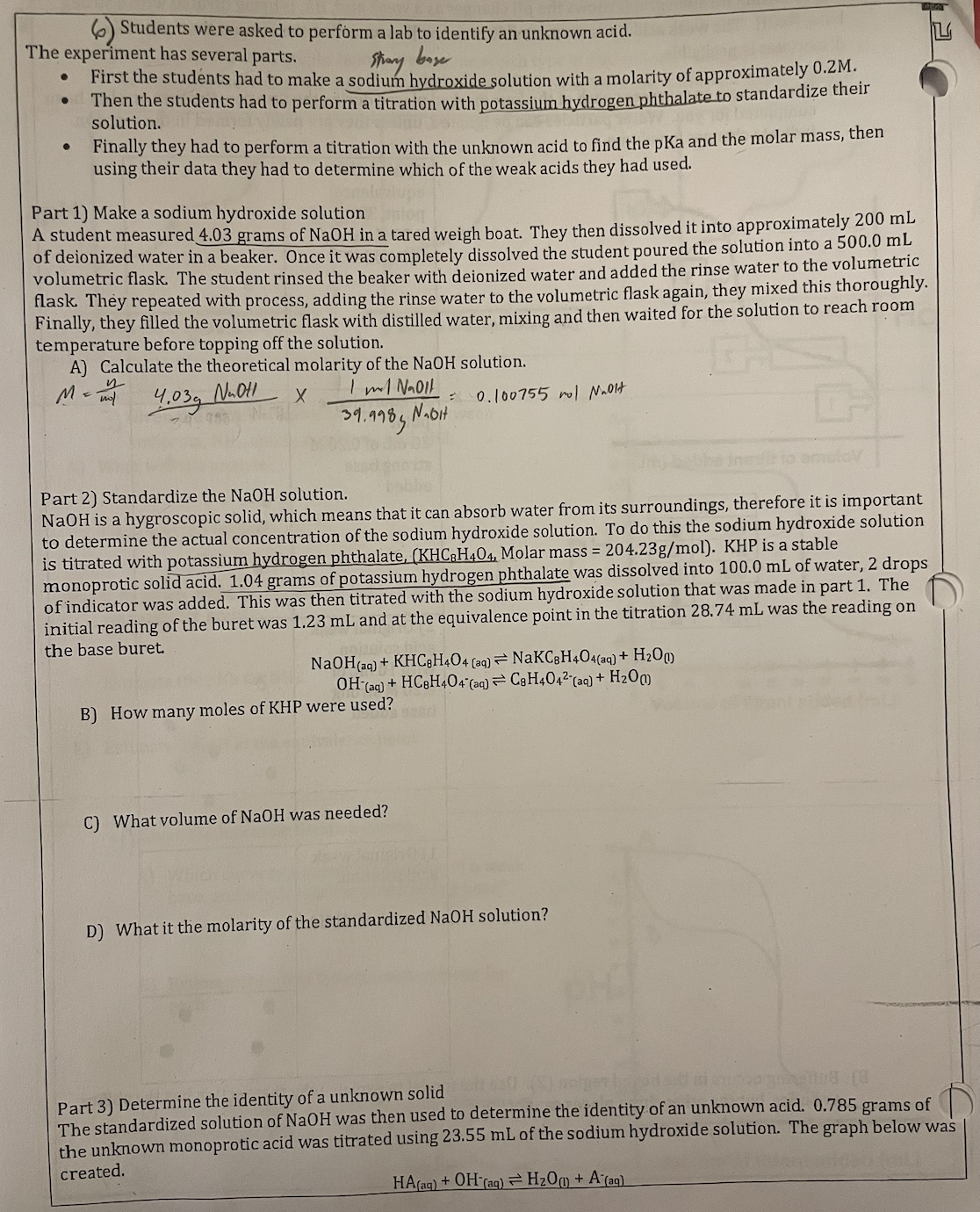Chemistry: Principles and Practice
3rd Edition
ISBN:9780534420123
Author:Daniel L. Reger, Scott R. Goode, David W. Ball, Edward Mercer
Publisher:Daniel L. Reger, Scott R. Goode, David W. Ball, Edward Mercer
Chapter16: Reactions Between Acids And Bases
Section: Chapter Questions
Problem 16.102QE
Related questions
Question
I know it's a lot, but I would really appreciate some help!

Transcribed Image Text:Story
base
Students were asked to perform a lab to identify an unknown acid.
The experiment has several parts.
First the students had to make a sodium hydroxide solution with a molarity of approximately 0.2M.
Then the students had to perform a titration with potassium hydrogen phthalate to standardize their
solution.
Finally they had to perform a titration with the unknown acid to find the pKa and the molar mass, then
using their data they had to determine which of the weak acids they had used.
Part 1) Make a sodium hydroxide solution
A student measured 4.03 grams of NaOH in a tared weigh boat. They then dissolved it into approximately 200 mL
of deionized water in a beaker. Once it was completely dissolved the student poured the solution into a 500.0 mL
volumetric flask. The student rinsed the beaker with deionized water and added the rinse water to the volumetric
flask. They repeated with process, adding the rinse water to the volumetric flask again, they mixed this thoroughly.
Finally, they filled the volumetric flask with distilled water, mixing and then waited for the solution to reach room
temperature before topping off the solution.
A) Calculate the theoretical molarity of the NaOH solution.
M = mol
Nuot
4.03g
X
1 ml NaOll
Nabit
39.9985
Part 2) Standardize the NaOH solution.
NaOH is a hygroscopic solid, which means that it can absorb water from its surroundings, therefore it is important
to determine the actual concentration of the sodium hydroxide solution. To do this the sodium hydroxide solution
is titrated with potassium hydrogen phthalate, (KHC8H404, Molar mass = 204.23g/mol). KHP is a stable
monoprotic solid acid. 1.04 grams of potassium hydrogen phthalate was dissolved into 100.0 mL of water, 2 drops
of indicator was added. This was then titrated with the sodium hydroxide solution that was made in part 1. The
initial reading of the buret was 1.23 mL and at the equivalence point in the titration 28.74 mL was the reading on
the base buret.
0.100755 rol Nooit
NaOH(aq) + KHC8H404 (aq) NaKC8H404(aq) + H₂O
OH(aq) + HC8H404°(aq) ⇒ C8H404² (aq) + H₂O)
B) How many moles of KHP were used?
C) What volume of NaOH was needed?
D) What it the molarity of the standardized NaOH solution?
L
netges od
08 (8
Part 3) Determine the identity of a unknown solid
The standardized solution of NaOH was then used to determine the identity of an unknown acid. 0.785 grams of
the unknown monoprotic acid was titrated using 23.55 mL of the sodium hydroxide solution. The graph below was
created.
HA(aq) + OH(aq) = H₂O + A (aq)
Expert Solution
This question has been solved!
Explore an expertly crafted, step-by-step solution for a thorough understanding of key concepts.
This is a popular solution!
Trending now
This is a popular solution!
Step by step
Solved in 6 steps

Knowledge Booster
Learn more about
Need a deep-dive on the concept behind this application? Look no further. Learn more about this topic, chemistry and related others by exploring similar questions and additional content below.Recommended textbooks for you

Chemistry: Principles and Practice
Chemistry
ISBN:
9780534420123
Author:
Daniel L. Reger, Scott R. Goode, David W. Ball, Edward Mercer
Publisher:
Cengage Learning


Chemistry & Chemical Reactivity
Chemistry
ISBN:
9781133949640
Author:
John C. Kotz, Paul M. Treichel, John Townsend, David Treichel
Publisher:
Cengage Learning

Chemistry: Principles and Practice
Chemistry
ISBN:
9780534420123
Author:
Daniel L. Reger, Scott R. Goode, David W. Ball, Edward Mercer
Publisher:
Cengage Learning


Chemistry & Chemical Reactivity
Chemistry
ISBN:
9781133949640
Author:
John C. Kotz, Paul M. Treichel, John Townsend, David Treichel
Publisher:
Cengage Learning

Chemistry & Chemical Reactivity
Chemistry
ISBN:
9781337399074
Author:
John C. Kotz, Paul M. Treichel, John Townsend, David Treichel
Publisher:
Cengage Learning
